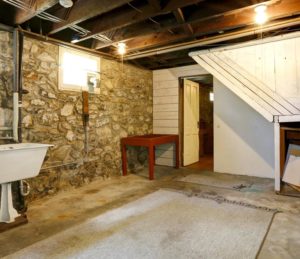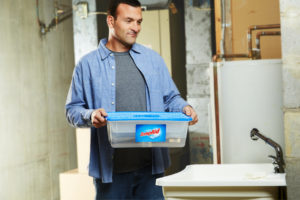
Moisture is a common problem in basements. A damp or musty smell is unpleasant whether you have an unfinished, partially finished, or fully finished basement. Even if you rarely use your basement ductwork, other connecting airways can bring unpleasant odors, mold or mildew into the rest of your home.
Moisture in the Basement
According to the EPA, the key to mold control is moisture control. If mold is present it should be cleaned up first. After the mold is properly handled or before it starts growing, you should begin working to remove moisture. The EPA recommends that water damaged areas be dried within 24-48 hours. Mold spores begin growing when they come into contact with wet surfaces. It is important to note that mold will not grow without moisture.
To remove moisture the source of the water should be identified and fixed. A common cause of moisture in the basements is when the ground slopes towards the building foundation. The EPA recommends that the ground slope away from the building to prevent water from entering the house. If the floor of the basement is dirt, covering it with plastic can help prevent water vapor coming from the ground. Other sources for water to enter the house include windows and doors. An important question to ask yourself is “did it rain recently?” Heavy rain can often reveal leaks in the house that would otherwise go unnoticed.
The most common culprits are either water leaks from plumbing or high humidity in the air. Both of these issues can cause structural damage, paint damage, or health problems. Plumbing leaks can include pipes, toilets, showers, sinks, or bathtubs.
In order to narrow down the cause, check for damp spots or water stains on the walls, ceiling, and floor. Localized problems are more likely to be caused by leaks, while moisture covering larger areas may be caused by humidity. If the problem does seem to come from a leak, whether plumbing or structural, have the problem fixed immediately. If the problem isn’t a leak, spill etc. then consider the possibility of high humidity.
Humidity
A warning sign of humidity is the presence of condensation. This can often be seen on windows, walls or pipes. The EPA recommends that relative humidity be kept between 30% and 50%. Condensation can be reduced by reducing humidity, increasing ventilation, insulating cold surfaces, and increasing the temperature of the room.
Ventilation fans can also be used to control moisture in kitchens and bathrooms. It is important to make sure all ventilation fans are installed to vent directly outside and are not blocked by lent or other material.
How DampRid Can Help
The Mega Moisture Absorber is best for areas with ongoing excess moisture problems. DampRid moisture absorbers attract and trap excess moisture to eliminate musty odors and prevent moisture damage in:
- basements

- closets
- laundry rooms
- bathrooms
- vacation homes
- storage sheds
- boats
- and RVs
The hi-capacity refillable container holds five pounds of all-natural crystals to last up to six months. You only need to refill twice a year.
How to use DampRid
- Remove lid and cut open the bags of crystals.
- Pour crystals evenly into tray and replace the lid.
- Place on flat surface in the desired location.
- For faster absorption, remove the safety cover. Note: Once removed it cannot be reattached.
- Crystals start working immediately, but it may take up to 2 weeks for brine to drip into bottom chamber.
- After crystals have completely dissolved, remove tray and empty liquid into toilet.
- Refill with DampRid Moisture Absorber Refill products.
